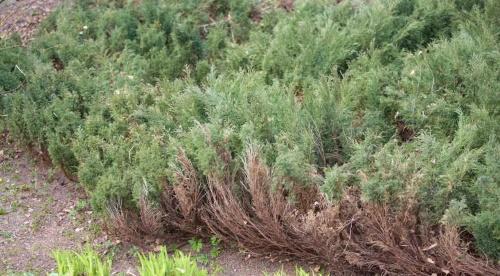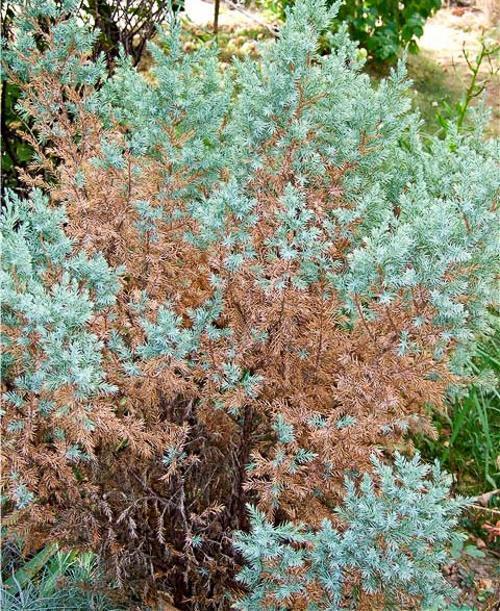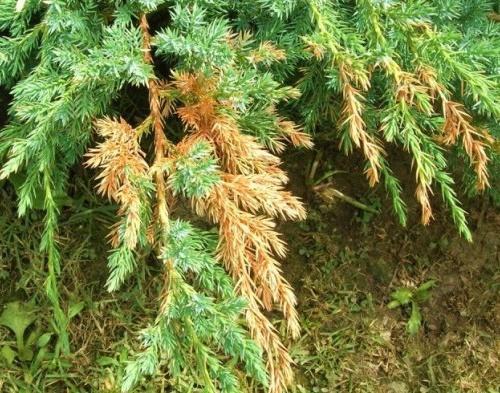Reasons why juniper turns yellow in spring, and ways to solve the problem
 Lush green juniper bushes look beautiful in any composition, but sometimes they can upset their owner. One of the most common problems when growing conifers is the yellowing of the needles themselves, and most often it can be noticed in the spring. In order to help your pets, you need to determine the reason why the junipers turned yellow after winter, and then it will become clear what can be done to save them.
Lush green juniper bushes look beautiful in any composition, but sometimes they can upset their owner. One of the most common problems when growing conifers is the yellowing of the needles themselves, and most often it can be noticed in the spring. In order to help your pets, you need to determine the reason why the junipers turned yellow after winter, and then it will become clear what can be done to save them.
Conifers turn yellow and can dry out as a result of such factors:
- sunburn;
- diseases;
- pests.
Harmful rays
As you know, the spring sun is already shining brightly enough and under its influence the conifers begin to actively wake up, starting the processes of photosynthesis. But at the same time, shrubs also need moisture, which is not yet fully warmed up land cannot provide them. As a result, the needles turn yellow and dry out, especially on the southern side of the plants.
To avoid such a situation, it is necessary to shade the juniper in early spring with a woven material, as well as warm up the soil by spilling it with warm water.
Varieties that are characterized by a vertical shape should be tied for the winter, and horizontally growing conifers should be periodically freed from the snow cover. If this is not done, the shoots will become brittle under the weight of the snow, which will cause the needles to dry out.
Yellowing of needles as a manifestation of the disease
Most coniferous diseases also provoke drying of the needles. So, juniper turns yellow in case of damage to such diseases:
- Rust... On the branches and needles, yellow growths are formed, which gradually thicken and turn into wounds. Spores get on the bushes from the affected deciduous garden species growing in the neighborhood (apple, pear, hawthorn). Treatment: removal of all diseased fragments, including on neighboring crops, and treatment of healthy shoots with fungicides.
- Drying of shoots with fungal infections... The needles turn yellow and crumble, and small spores are visible on the bark in spring. Treatment: similar to rust fighting.
- Schütte... The disease completely "shows itself" in the summer: dark spots become visible on the needles, the needles turn yellow and die off. Treatment: spraying with Quick or Quadris, pruning affected branches.
- Cancer... With biorellic cancer, the bark on the branches cracks, turns yellow and dies, leading to yellowing of the needles and the complete death of the plant. Nectrium cancer also causes the needles to die off, and reddish growths form on the branches. Treatment: in both cases, with a massive defeat, junipers are best destroyed. But if you notice the disease in time, you can fight for them by cutting off diseased branches and treating the bushes with Skor or Vector.
All trimmed parts of diseased junipers must be burned to prevent the spread of the disease.
Harmful insects
No less danger is for juniper and pests that suck juices from the plant, provoking yellowing of the needles. Shrubs get the most from insects such as:
- aphid;
- shield;
- mite;
- gall midges;
- sawfly;
- moths;
- mole.
If pests are found on the bushes, they must be treated with appropriate insecticides.